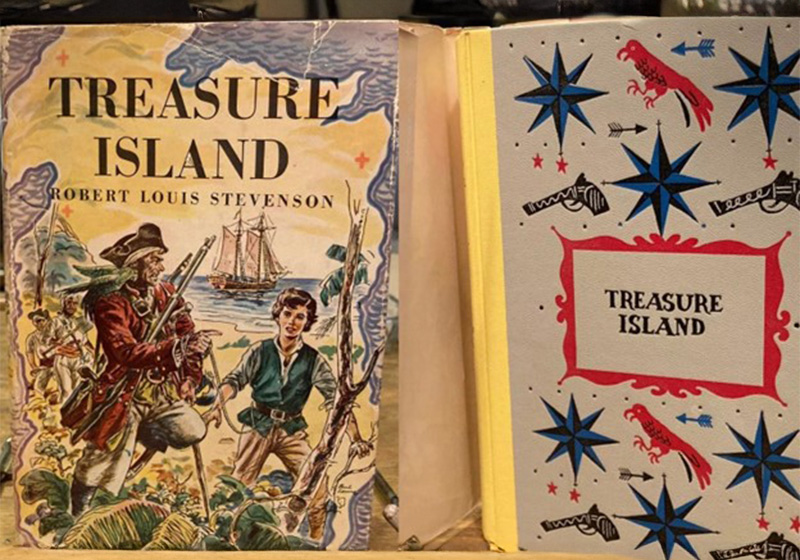Table of Contents
What makes a swashbuckling pirate story? A voyage on the high seas, buried treasure, a mutiny and a one-legged seadog are likely high on your list. Yet these tropes didn’t come from nowhere: they came from a novel written by a young Scot at the end of the 19th century. A novel that became one of the most famous children’s books of all time… we are of course talking about Robert Louis Stevenson’s Treasure Island.
Which of these pirate themes have made it onto the front of Stevenson’s masterpiece? And what’s the best cover art to have graced this seminal children’s adventure over the years?
Gather round me hearties! A yarn ’bout to be spun…
Early editions and the lost map
The idea for the world’s most famous pirate story came to Robert Louis Stevenson while entertaining his stepson one rainy afternoon. Before it appeared as a novel, Treasure Island was serialised in a children’s magazine called Young Folks in 1881. It was first published as a single volume on 14 November 1883 by Cassel & Co of London.
As we’ve noted before on this blog, book covers in the 19th century tended to be rather staid affairs (with a few notable exceptions). But some early editions of Treasure Island bucked this trend with decidedly adventurous covers. One of these was the limited-edition illustrated volume published by Cassel & Company in 1899. The navy blue cover depicts a skirmish between the young Jim Hawkins and a mutineer atop the mast of the Hispaniola, the vessel on which much of the story is set.

The first American edition was published in 1884 by Boston Roberts Brothers. Compared to its British counterpart, the cover to this edition (the first to be illustrated) is far more appealing and features a compass and a pirate ship. And inside, before the title page, comes the famous treasure map.

There’s an interesting anecdote behind the treasure map. Originally drawn by Stevenson’s stepson Lloyd Osbourne when the pair were devising an outline for the story, the map would play a key part in the novel. But when Stevenson sent the manuscript to the publishers in London, the map was lost. A desperate Stevenson turned to his father – an engineer and respected lighthouse designer – to help him recreate the drawing based on the description given in the novel itself.
Covers illustrated by Edmund Dulac

In 1927, a special edition of Treasure Island was released featuring pastel-hued yet action-packed illustrations with an obvious Oriental influence. It was illustrated by Edmund Dulac, a French-born naturalised Briton, and published in just 50 numbered copies by Ernest Benn of London.
Edmund Dulac is a key figure from the so-called golden age of illustration, which ran roughly from 1880 to 1930. He produced art for countless great works of literature, including One Thousand and One Nights, The Tempest, Sleeping Beauty and the poetry of Edgar Allan Poe.

Their quality was such that, in later years, Dulac’s illustrations would often be used on covers for editions around the world.
Vintage covers with pirates and the fearsome Long John Silver
One of Treasure Island‘s main characters is Long John Silver. In a conventional novel, this peg-legged pirate would have been a two-dimensional baddie. But in Stevenson’s tale Long John Silver is a complex and compelling character. Though undoubtedly a villain, he lives by a certain code of honour and takes a shine to the book’s hero, the young Jim Hawkins. And he owns what is perhaps the most famous pet bird in fiction: Capitan Flint the parrot.
Unsurprisingly, the iconic Long John Silver and his motley crew appear on many a Treasure Island cover. Here’s a selection of vintage covers with buccaneering art.




Galleons, parrots and pirates: Penguin covers for Treasure Island.
Also worth mentioning is the cover art for Penguin editions of Treasure Island, many of which carry repeated patterns of key elements from Stevenson’s story.
Our favourite has to be the parrot motif on this deluxe clothbound edition.

The linocut cover by Stanley Donwood, Radiohead’s go-to graphic designer
One of the great contemporary designers to try their hand at a Treasure Island cover is Stanley Donwood, best known for his album art for rock band Radiohead. For his elegant and abstract cover, Donwood explains, he used linocut, a DIY engraving technique using linoleum. The resulting image of rough seas and billowing clouds was then coloured in hues of blue and gold by renowned cover designer David Pearson.

The cover was commissioned in 2010 by White Books for their Fine Editions series of literary classics. Stanley Donwood created the cover art for every single Radiohead album since 1994, and has designed other material for the band, too, including posters, book covers and their website. He is also a respected artist and engraver in his own right.
Treasure Island covers from around the world
Robert Louis Stevenson wrote the world’s most famous pirate story. A bestseller that spread around the world in no time: the first Chinese translation appeared in 1904. And, who knows, perhaps one day there will be an edition in the native language of Samoa, the tropical archipelago where the author spent his final years.
Before we go, here’s an assortment of the international covers for Treasure Island that we like most.
We kick off with the first French edition. Published in 1885 by Hetzel, the cover art depicts a lush jungle on Treasure Island.

Then there’s a Taiwanese edition from 2019 showing the young Jim Hawkins and Long John Silver at sea.

The cover of the Arabic edition published by Takween Publishing showing the protagonists in silhouette.

Captain Flint and a series of classic tropes appear on the cover of an Armenian edition of Treasure Island published in 2022.

Last of all, we have a Russian edition. We love the idea of Jim Hawkins daydreaming about adventures on the high seas!

What’s your favourite Treasure Island cover?

